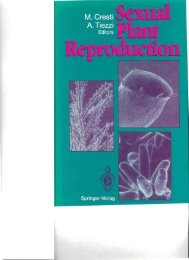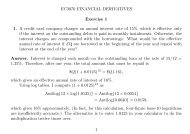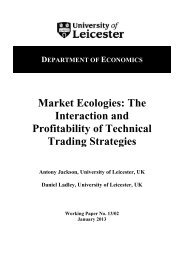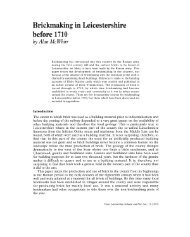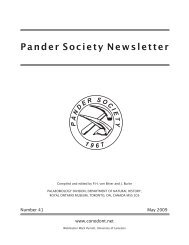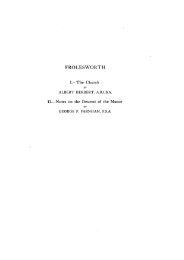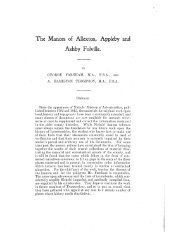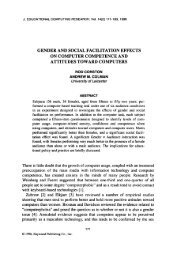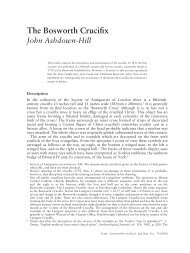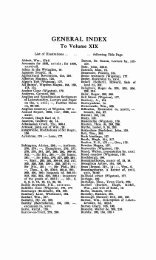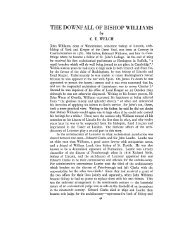Pander Society Newsletter - University of Leicester
Pander Society Newsletter - University of Leicester
Pander Society Newsletter - University of Leicester
You also want an ePaper? Increase the reach of your titles
YUMPU automatically turns print PDFs into web optimized ePapers that Google loves.
initiatives such as the Chronos System and the Palaeontological Database. The focus <strong>of</strong> this project is to<br />
improve the CONOP s<strong>of</strong>tware used for the Chronos Web through decreasing problems faced when crossing<br />
facies boundaries between carbonate-dominated facies into shale-dominated facies.<br />
Jau-Chyn Liao (aka Teresa). As a Ph.D. student I am working on Givetian and Lower Frasnian conodonts<br />
from the Pyrenees. My main point is to establish a fine biostratigraphical scale for the Givetian and to<br />
contribute to the current decisions concerning Givetian subdivision. Another important issue is the<br />
recognition <strong>of</strong> the Eifelian/Givetian and Givetian/Frasnian boundaries and to establish the origin and<br />
succession <strong>of</strong> the genus Ancyrodella in the Pyrenees. Two years ago I started to work on Givetian/Frasnian<br />
micr<strong>of</strong>acies with P. Königsh<strong>of</strong> & E. Schindler. Several presentations on biostratigraphy and interpretation<br />
on paleoenvironments (with Ph.D. advisor Nacho Valenzuela) at Siberian meeting in Novosibirsk.<br />
Anita Löfgren. Continuing research on Lower and Middle Ordovician conodonts (with help from many<br />
friends). Microzarkodina is still in focus, as it is the topmost Cambrian cordylodid from Sweden, and the<br />
position <strong>of</strong> the base <strong>of</strong> the Middle Ordovician in Sweden. I am now <strong>of</strong>ficially retired from teaching, but still<br />
retain my <strong>of</strong>fice for research.<br />
Friedrich W. Luppold. Conodont research activities in the Harz Mountains continue.<br />
Alexander (Sandy) D. McCracken. I continue to work on Middle to Upper Ordovician, Silurian,<br />
Devonian and Carboniferous conodonts from various locations in Canada. Much <strong>of</strong> my time is now<br />
assigned to outreach and paleontological databases.<br />
Timothy R. McHargue. No conodont research ongoing at moment, but I am hopeful that I will be<br />
returning to conodont work soon.<br />
Peter MacKenzie. Passive conversations with Stig. I am now self-employed!<br />
Peep Männik. Continuing to work on the evolution, ecology and taxonomy <strong>of</strong> Ordovician and Silurian<br />
conodonts from Baltic, Arctic regions and Siberia, as well as on conodont-based high-resolution<br />
stratigraphy.<br />
Ana Márquez Aliaga. Iberian (western Tethys) Triassic paleobiology and biostratigraphy.<br />
Richard Marshall. As an avocational conodont “researcher” and collector I have not been very active for<br />
the last several years, however, I am planning to be more active in my (almost exclusive) Pennsylvanian<br />
mid-USA interests.<br />
Adelaide Mastandrea. Involved in biostratigraphic studies <strong>of</strong> the Carnian/Rhaetian conodonts in the<br />
Northern Calabria and Basillicata (southern Italy). I am still involved in a project dealing with Kubler Index<br />
(KI) and CAI.<br />
Hanna Matyja. Administration dominated my last several years and half <strong>of</strong> 2005. Fortunately it is over<br />
and I have got a good chance to getting back to proper conodont research and to fulfilling some <strong>of</strong> my<br />
obligations to co-authors. Studies involving Devonian and Mississippian conodonts continue at various<br />
paces. The manuscript on the Devonian and Mississippian stratigraphy and facies development in NW<br />
Poland (Western Pomerania), including also a comparative study with adjoining areas (Lithuania, Latvia in<br />
the east and north-eastern Germany in the west), has been completed and a paper will be published this<br />
year. Several papers are in progress, with E. Turnau on the Middle Devonian and Frasnian conodont and<br />
palynomorph biostratigraphy, as well as on the Givetian/Frasnian boundary. I have also started work on<br />
Mississippian facies distribution in NW Poland. Work (with A. Tomas) has commenced on the tectonic and<br />
climatic controls on sedimentation and distribution <strong>of</strong> foraminifer faunas during the Famennian. With coauthors<br />
also engaged in integrated conodont-miospore-foram biostratigraphic, sedimentologic, event<br />
stratigraphic, and magnetic susceptibility study <strong>of</strong> the Middle and Upper Devonian in NW Poland. A new<br />
project on high resolution biostratigraphy and event stratigraphy close to the Devonian/Carboniferous<br />
boundary will begin this year.<br />
Ruth Mawson. Concentrating on Early Devonian faunas from the Rockhampton area, NSW, central and<br />
western NSW and New Zealand and on Late Devonian conodont faunas from NW Xinjiang. At MUCEP<br />
four years ago we introduced a double degree (BSc with BA); the compulsory major is Palaeontology. This<br />
year 3 very bright students who enrolled in this degree are now doing Honours in Palaeontology!<br />
S. Meco. Retired in 2005 but still working on Triassic conodonts.<br />
Carlos A. Méndez. Working on Carboniferous (Pennsylvanian) conodonts in the Cantabrian Mountains<br />
(North Spain). The levels close to the Bashkirian-Moscovian and Moscovian-Kasimovian boundaries are<br />
my main points <strong>of</strong> interest.<br />
Glen K. Merrill. Continuing work on Gondolella (with P.H. von Bitter) and also a large project on the<br />
Pennsylvanian rocks and faunas <strong>of</strong> southeast Ohio (USA).<br />
18



